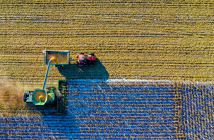The world population will grow to 9.1 billion by 2050. Food demand is predicted to increase by 70%. We will need to harness technology to be able to feed everybody in the future. And we already have some stupendous ideas on the boil.
Currently drones are mostly used as playthings. People strap video cameras onto drones and film themselves surfing or getting married. Amazon are making wild claims that they will use drones to deliver goods from their website. But some more meaningful and practical uses of drones are coming to a farm near you.
Now, drones are being developed to help farmers shave hours off their workload. In Japan and in the United States, things are getting impressive with drone farming already underway. American corn farmers are sending up drones over their fields. The drone gathers images of the fields, then run these images through different algorithms. The outcome of this analysis gets sent back to an iPad or computer, with detailed information about what parts of the crop are doing well and what parts are lagging. The farmer is then notified as to what parts of the fields might be doing a battle with disease, hungry insects, or a lack of water.
This can take just minutes, as opposed to spending hour upon hour on foot, inspecting the crop across a large tract of property. One missed diseased area could lead to an entire crop being destroyed weeks later if a farmer misses the early signs. Drones can be more accurate and faster, saving a farmer hours in “scouting” time and in crop disease prevention.
Drones on farms have multiple uses. In other areas of farming, farmers are starting to use drones as “sheepdogs”…the drones herd sheep into different fields while the farmer stays all warm and comfy in the sitting room. Nice!
Drones are becoming more compact and more affordable with every year that passes. In the U.S. a complex farm drone is $5000, and this price is expected to come down as demand surges. But there are simpler, cheaper drones available, depending on what you need to do with your fields. The good news is that you don’t need a super-fancy drone to get you an advantage over your farming workload. Even compact drones can tell farmers where pesticides and fertilisers need to be applied in their patchwork of fields. This saves not only time, but also money: spot spraying is cheaper and more environmentally friendly that spraying down a whole field.
So what is happening in Ireland in this field of farming technology? Green Aviation is Ireland’s largest commercial drone company. They aim to disrupt the current commercial marketplace by convincing farmers to go for a drone. They claim that when using their technology, businesses will be 30% more cost efficient and 90% more energy efficient.
Green Aviation offer a selection of drones ranging from 11kg to 150kg in weight, with flying cameras weighing between 3kgs to 35kgs. Plus they have a service that integrates data with the images the cameras are collecting. And it’s not just farmers who can benefit from drones. Green Aviation CEO Oisin Green, says, “Clients come to us with an array of different requirements. Utility companies for example, who currently would use helicopters to monitor the National Grid, are switching to our large, industrial Inspection drone. It is silent, while the helicopters are very loud, particularly at low levels, which disturbs livestock. Wind farm operators on the other hand, need a small, efficient flying camera to inspect infrastructure at great heights.”
Oisin previously worked as a commercial airline pilot flying Boeing 737 aircraft, and within the Irish Army retiring in the rank of Captain. He decided to set up Green Aviation after working on a drone procurement project for the Irish Defence Forces and realising the potential for commercial drones in Ireland. His company plans to release farming drones next year. “We will hopefully bring the service to market in the near term. We are exploring what kind of information would be of use to farmers in running their farms. Drone surveillance and data collection will be of huge benefit to the large agriculture sector in Ireland.”
If you are a farmer then perhaps it is time to starting googling the drone lifestyle.







